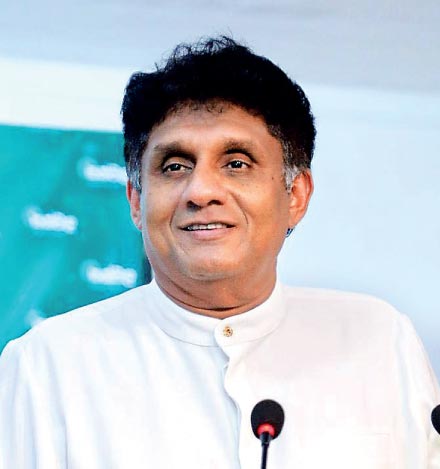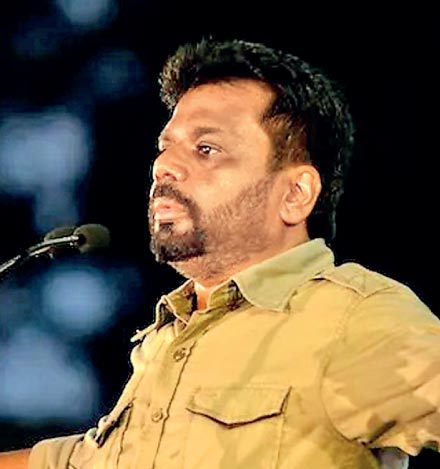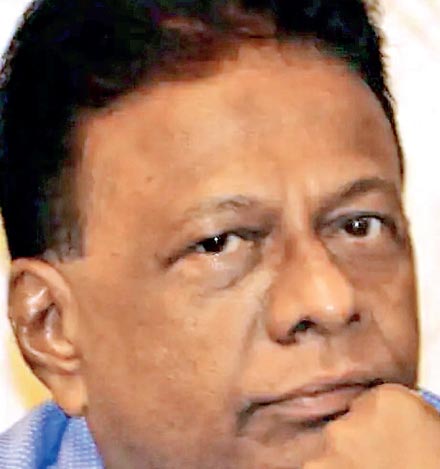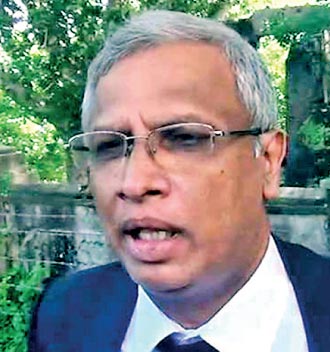Thursday Jan 01, 2026
Thursday Jan 01, 2026
Thursday, 14 December 2023 00:30 - - {{hitsCtrl.values.hits}}

Can he clinch an alliance?

Needs political allies, partners

Crucial ally and partner

Should dialogue with AKD

Wickramaratne’s worldview
 Sajith Premadasa has declared that he will not reunite with Ranil, nor will the SJB realign with the UNP. (https://www.ft.lk/front-page/Sajith-dismisses-future-alliance-with-Ranil/44-756217)
Sajith Premadasa has declared that he will not reunite with Ranil, nor will the SJB realign with the UNP. (https://www.ft.lk/front-page/Sajith-dismisses-future-alliance-with-Ranil/44-756217)
That makes perfect sense. The electricity price hikes, VAT shock, hollowing of public health and education, and mounting hunger will cumulatively obliterate Ranil’s presidential prospects. If he stalls the election, a social firestorm will obliterate much more.
Why should Sajith and the SJB buy tickets on that Titanic? If they do so, the irresistible public compulsion to “throw the rascals out” will include them, and the protest vote will have only one channel. As in 1970, 1977 and 2019-2020 a unipolar or one-party-dominant outcome will ensue, wrecking the democratic system’s equilibrium.
Lines of demarcation
That said, Sajith must explain why he says ‘no’, beyond the banality of “Ranil is with the Rajapaksas who ruined the country”. What if Ranil and the UNP are willing to swap the Rajapaksas and the SLPP for Sajith and the SJB?
Sajith must draw the line of demarcation between him and Ranil, the SJB and the UNP, in substantive terms of economic and social strategy, policy paradigm, developmental program, and political ideology. That is possible only if he stands firmly on the foundation of President Premadasa’s development philosophy which includes “economic, political and social democracy”.
Sajith must guarantee that his economic team doesn’t ‘unite’ or ‘align’ with Ranil’s program and ideology. If the SJB looks like the UNP, walks like the UNP and quacks economics like the UNP, it is a twin, an avatar or extension of Ranil’s UNP.
The SJB economic platform represents policy continuity with Ranil, not change. The Harsha-Eran economic model has 5 pillars which make it morphologically Ranilian:
(1) Renewed access (through an IMF rubber-stamp) to the foreign money markets, i.e., a return to the original addiction.
(2) A castrated Central Bank incapable of state intervention to offset external shocks i.e., do a Mahathir.
(3) Unilateral rewriting of the Social Contract in favour of foreign and local big capital, by scrapping labour and land reform laws.
(4) Unfettered, maximum—not optimum—privatisation and foreignisation of the economy, deleting the state and cooperative sectors.
(5) Retention of the 2017 foreign exchange law which facilitates outflow and loss to the country of hard currency earnings.
Weighed-down by the albatross of Harsha’s Economic Blueprint, Sajith is handicapped in 2024 in his ability to compete with the JVP-NPP by losing the liability of a UNP profile as Ranasinghe Premadasa so easily did in 1988.
On economics and external affairs, SJB ideologues are set to resume the 2015-2019 Ranil-Mangala-UNP project and policy trajectory. This positions the SJB as part of the problem, not the solution; part of the old elitist Establishment, not the agency of progressive change. Thus, during the post-Aragalaya period and the Ranil presidency, SJB has failed to enthuse the public imagination.
Wickramaratne’s warped worldview
I read with a mix of interest and incredulity, ex-banker Eran Wickramaratne’s profound pronouncements in Parliament on Sri Lanka’s foreign policy.
 “…We belong to the non-aligned movement, which is a platform only. Our Foreign Policy must be multi-aligned with nations and global agencies which are currently yielding global power,” he said…He opined that the foreign policy strategy and engagement must have economic diplomacy at the core of its policy formulation…”
“…We belong to the non-aligned movement, which is a platform only. Our Foreign Policy must be multi-aligned with nations and global agencies which are currently yielding global power,” he said…He opined that the foreign policy strategy and engagement must have economic diplomacy at the core of its policy formulation…”
(https://www.ft.lk/news/SL-s-passport-ranking-reflective-of-its-foreign-policy-Eran/56-756124)
‘Multi-alignment’ was custom-tailored for India. It suits Delhi’s membership of the Quad and its close friendship with Russia. This policy is affordable by a country as vast, wealthy, populous and powerful as is India. Significantly, even middle-powers and fellow members of BRICS such as Brazil and South Africa have not renounced nonalignment in favour of ‘multi-alignment’.
The stance of most states in the global South in relation to the Ukraine war has been described by US scholars as ‘the new nonalignment’ and as confirmation of Shivshanker Menon’s conceptual commendation a few years ago of ‘Non-Alignment 2.0’.
Multi-alignment for India and Sri Lanka would mean two vastly different outcomes. It reminds me of the tale of two friends, a hen and a pig, walking down the road looking hungrily for a place to eat. They spot a place with a board that announces ‘Open for Breakfast! Bacon and Eggs!’ “Let’s go in, I’m starving” the hen says to the pig. The pig replies “No way! You go in, it would be easy for you, but for me it would mean a total commitment”.
For a small island such as Sri Lanka, ‘multi-alignment’ would mean inviting the power-projection by and the presence of contending Great Powers or their equivalent of an ‘East India Company’, carving out our compact space into spheres of influence.
Given our axiomatic geopolitical location, this would nullify Sri Lanka’s independence, sovereignty, territorial integrity and unity. We would lose whatever multi-directional (multi-vector) autonomy we have in the world arena.
Given American military enabling of Israel’s Gaza bombing, the two US carrier battle-groups backstopping Israel, and the appalling US veto at the UN Security Council of the resolution calling for an immediate ceasefire in Gaza, what stance would a ‘multi-aligned’ rather than a ‘non-aligned’ Sri Lanka adopt on the Gaza war?
How could we be multi-aligned to both the USA and China in the context of sharp competition and contention? Sri Lanka’s national interest is better served by remaining ‘nonaligned between’ rather than ‘multi-aligned with’ contending Great Powers.
An increasingly frequent term in international discourse, including that of Prime Minister Modi as Chairman of G20, is the ‘Global South’. While straying into the realm of foreign policy, Eran Wickramaratne and Harsha de Silva have conspicuously avoided any acknowledgement of Sri Lanka’s identity as belonging to the Global South, which must surely anchor our foreign policy in an ontological sense. Similarly conspicuous by its absence in their discourse is a commitment to a multipolar world.
Meanwhile “economic diplomacy” is crucial but is certainly not “the core” of [foreign] “policy formulation” as Wickramaratne supposes. Kissinger would have been shocked to his core.
Alliance impeded
A 2024 version of the 2015 Yahapalanaya strategy will lack its most essential component: a credible dissident faction of the centre-left, at the time personified by Maithripala Sirisena, the popular General-Secretary of the SLFP. Today’s equivalent would be an alliance in which the main partnership would be between the SJB and the FPC led by Dullas Alahapperuma, i.e., a Sajith-Dullas ticket or as close to one as our presidential system which has no Vice-Presidential spot can get. This would balance an SJB-led bloc and give Sajith a capacity for outreach to disaffected MR-SLFP-SLPP voters.
As our Sunday sister-paper spotlighted in its Politics column, the main obstruction to an Opposition alliance seems to be the SJB’s commitment to its para-Ranilist/para-UNP Economic Blueprint.
 “…One was a heated debate last Wednesday among parliamentarians of the Freedom People’s Congress (FPC), a breakaway group from the Sri Lanka Podujana Peramuna (SLPP), to form a common front with the main opposition Samagi Jana Balavegaya (SJB). For months now, the FPC has been talking to SJB leadership but has not been able to reach an understanding on an acceptable economic policy. At a meeting this week, the majority view was that they should agree to a political tie-up only based on a set of mutually acceptable terms…It was agreed that the FPC has another meeting with SJB leader Sajith Premadasa to further determine future action.” (https://www.sundaytimes.lk/231210/columns/constitutional-council-the-crisis-continues-541856.html)
“…One was a heated debate last Wednesday among parliamentarians of the Freedom People’s Congress (FPC), a breakaway group from the Sri Lanka Podujana Peramuna (SLPP), to form a common front with the main opposition Samagi Jana Balavegaya (SJB). For months now, the FPC has been talking to SJB leadership but has not been able to reach an understanding on an acceptable economic policy. At a meeting this week, the majority view was that they should agree to a political tie-up only based on a set of mutually acceptable terms…It was agreed that the FPC has another meeting with SJB leader Sajith Premadasa to further determine future action.” (https://www.sundaytimes.lk/231210/columns/constitutional-council-the-crisis-continues-541856.html)
Roshan Ranasinghe, a decent enough young Pohottuwa politician, just doesn’t have Dullas Alahapperuma’s and Charitha Herath’s heft and the FPC’s market-niche. Without the FPC as main partner, the SJB’s alliance will look like an old-fashioned ‘UNP plus minority parties’ bloc, albeit with Sajith’s sporadic sprinkling of populism as thin overlay. If Dullas’ FPC partners with the SJB on an economic platform of a liberal market character rather than a new, progressive-centrist Common Program, it will splinter as well as lose its vote-base as Sirisena’s SLFP did in alliance with Ranil’s UNP.
That the stumbling block of the (Advocata-advised) economic platform hasn’t been removed by Sajith even in the pragmatic interests of clinching a deal with the FPC and catapulting a broad progressive alliance as Presidential Election Year 2024 commences, is evidence of the extent of ideological capture by the party’s neoliberal right-wing, and the degree to which it looks set to dominate policy in a Sajith administration. These rightist policy ideologues will do the same damage to a possible Sajith presidency that Ranil-Chandrika-Mangala did to the Sirisena presidency and its social base.
Tamil question, political solution
The Oct 7th Hamas attack and Israel’s monstrously evil war on the Palestinian people of Gaza –75% of those slaughtered being women, children and elderly, says the UN-- prove conclusively that problems which are political at the root, require political solutions or political settlement.
In the case of Israel/Palestine the obvious framework was a two-state solution as agreed upon in Oslo. It has since been rendered inoperable by Israel’s slicing away of territory through an aggressively annexationist settlement policy. Meanwhile a one-state solution is blocked by Israel’s apartheid model.
If there are territorial swaps, the two-state solution may still be salvageable. If the apartheid system is abandoned or overthrown, a one-state solution is possible. For now, the situation is bloodily, tragically intractable.
Sri Lanka is lucky that way.
 Ours was never an issue of invasion of neighbours, settlements, annexation, and Occupation as condemned by resolutions of the UN Security Council, i.e., international law.
Ours was never an issue of invasion of neighbours, settlements, annexation, and Occupation as condemned by resolutions of the UN Security Council, i.e., international law.
 Nor is there is internal apartheid, especially after the re-enfranchisement of the hill country Tamil people. All citizens have a right to vote and each and every minority can punch its electoral-demographic weight, especially under the electoral system of proportional representation.
Nor is there is internal apartheid, especially after the re-enfranchisement of the hill country Tamil people. All citizens have a right to vote and each and every minority can punch its electoral-demographic weight, especially under the electoral system of proportional representation.
 The military dimension was decisively deleted and a UN Human Rights Council endorsement decisively won (May 2009).
The military dimension was decisively deleted and a UN Human Rights Council endorsement decisively won (May 2009).
 Unlike the 1993 Oslo Accords, the 1987 political settlement is intact, though inoperative because of the opportunistic chicanery of the Yahapalanaya UNP-TNA in 2015-2017.
Unlike the 1993 Oslo Accords, the 1987 political settlement is intact, though inoperative because of the opportunistic chicanery of the Yahapalanaya UNP-TNA in 2015-2017.
 That political settlement is the system of elected Provincial Councils created by the 13th amendment in the wake of the Indo-Sri Lanka Accord.
That political settlement is the system of elected Provincial Councils created by the 13th amendment in the wake of the Indo-Sri Lanka Accord.
The Global Tamil Forum’s Suren Surendiran has always been impressively intelligent and it is a pity he won’t contest Sri Lanka’s parliamentary election. However, President Wickremesinghe played it more cannily when talking to the GTF. He scrolled the political calendar, beginning with the Presidential election, saying that the constitutional changes or change of Constitution would have to follow the elections. This left the door open for him to tempt Tamil voters while pre-empting a backlash.
The Provincial Councils cannot be unfrozen as long as Wickremesinghe is in office, not merely because he was the PM who sabotaged them, but also because he cannot be seen to spend on a PC election (primarily) for the North and East before holding the constitutionally dictated Presidential election 2024.
Which post-Ranil dispensation will be most conducive to a settlement of the ethnic issue? Certainly not the one that promises the Tamils the most generous solution, but rather the one that is more likely to be capable of delivering a sustainable solution.
Throughout the island’s political history, an Oppositional or governing alliance with a minoritarian profile has been the worst for the defence and advancement of minority rights and autonomy. This has been proved from 1956 to 2019.
In the formation of an Opposition Alliance, the pressure will be on the SJB to commit to the 2015 Constitutional change package. That pressure will come from the TNA in the process of forming an Opposition alliance at the beginning of Presidential Election year 2024. The SJB’s Eran Wickramaratne will support the TNA’s MA Sumanthiran in that effort. Sumanthiran himself will be more stridently insistent than usual because the succession struggle in the TNA is underway.
A TNA hard-sell will prove problematic for Sajith Premadasa and the SJB, but not because they will be open to chauvinist criticism from the NPP-JVP, which doesn’t display a trace of Sinhala- Buddhist chauvinism and is quite decided in its critique of discrimination, commitment to pluralism and retention/reactivation of the existing Provincial Council system. The threat to the SJB is that the NPP-JVP’s modernist, inclusive, moderate stance will be more in consonance with the vast majority of post-Aragalaya Sinhala voters, than will an SJB-TNA bloc with its 2015 Mangala Samaraweera designed, revealingly minoritarian profile.
If Sajith promises a return to the 2015-2019 process of a new Constitution, he will run for the presidency with a quasi-federalist ball-and-chain on his left leg, accompanying the Economic Blueprint ball-and-chain on his right leg.
If an SJB administration attempts a TNA-driven Constitution, the required Referendum will be a fast-track for the Sinhala Far Right.
If a Referendum is ought to be bypassed as urged by the 2015-2019 Constitutional change advisors, then an accursed cycle will repeat itself, beginning with a replay of JR Jayewardene’s March to Kandy against the Bandaranaike-Chelvanayakam pact of 1957. The ex-Gotabaya camp will swing into action, especially in the Eastern province where GR engaged in neo-Netanyahu-ism through his handpicked Governor and presidential Eastern Task Force.
Buddhist card
The problem cannot be addressed by burnishing Sajith’s genuine Buddhist credentials. The Senanayake UNP had a Sinhala-Buddhist profile as befits a conservative-liberal party. It sought to weaponise Sinhala-Buddhism against the Left. Piety and philanthropy didn’t save the UNP from the Hartal of 1953 and the landslide electoral defeats of 1956 and 1970.
Ranasinghe Premadasa, a Sinhala Buddhist who achieved a great deal as Minister of Buddha Sasana while simultaneously practising a multi-religious policy even more pronounced than Sajith’s, made it unambiguously clear that the broad-basing of a government, specially a UNP government, and buffering it against an ethnic majoritarian backlash to which the UNP was prone, resided not so much in the Senanayake formula of Sinhala Buddhist traditionalism but precisely in the domain of progressive socioeconomic policy, i.e., of equitable growth and rapid social upliftment. President Premadasa countered ethnoreligious majoritarianism with socioeconomic majoritarianism in which he firmly anchored his multi-lingual, multi-religious, multi-ethnic, multi-cultural pluralism.
As a parallel track (not a Track B), the Tamil and Muslim parties should open a serious dialogue with Anura Dissanayake and the NPP-JVP. The Left may prove a better delivery-vehicle because it is less vulnerable than the SJB with its neo-UNP, or not-quite-post-UNP vibe.
Intellectual sophistication
I was amused to read in the pages of an influential mainstream newspaper, the pronouncement of a popular young columnist, economic liberal and right-winger, that “the JVP…doesn’t have intellectual sophistication”.
I would love to watch a television debate of any 6-member panel of the UNP, SJB, SLPP or a combination, face off against a JVP-NPP panel of Anura Dissanayake, Bimal Ratnayake, Sunil Handunetti, Prof Hiniduma Sunil Senevi, Prof. Liyanage Amarakeerthi and Dr. Harini Amarasuriya. It is the Establishment’s good fortune and the JVP-NPP’s flawed tactics that deprive AKD’s camp of the formidable Pubudu Jayagoda, Duminda Nagamuwa and Wasantha Mudalige.
Anura and the NPP-JVP could find themselves electorally thwarted, not by their foes but by unrecognised complexity of terrain and time. Uneven development and intermediate strata make united fronts and alliances imperative. AKD and the NPP-JVP aren’t Gramscian enough, yet.